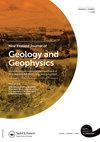深水航道岸上沉积波浪场结构演变的控制:来自新西兰近海Hikurangi海峡的见解
IF 1.9
4区 地球科学
Q1 GEOLOGY
New Zealand Journal of Geology and Geophysics
Pub Date : 2021-10-04
DOI:10.1080/00288306.2021.1978509
引用次数: 8
摘要
摘要深水河道可能会被溢出的沉积物所束缚,而溢出的水流通常带有沉积波。在这里,高分辨率测深、后向散射以及2D和3D地震数据被整合在一起,以识别对Hikurangi海峡河岸上方区域流动过程的控制。通过最浅的600进行了定性地震解释和沉积物波形态和分布的定量分析 m的地层一直延伸到海底。在整个研究地层中,仅在陆地边缘(左边缘向下看河道)存在四个外部弯曲波场。这些场最初是紧密间隔或组合的,后来演变成空间分离的;两个独立的波场进一步细分为不同的外弯场和内弯场,其组成波在形态和分布上产生了明显的差异。泥沙波浪特征用于解释过岸水流的方向和强度。确定了对这种流量和相关沉积的九种控制:流量与导管尺寸、河岸坡度、流量调节、科里奥利力、等深流活动、流量反射、离心力、与外部衍生流量的相互作用以及来自不同位置的溢流的相互作用。它们的相对重要性可能在空间和时间上随岸上地区的不同而变化,从而控制波场的发展,使得:(1)外部弯曲波场只在陆地边缘发展;(2) 随着时间的推移,离心力对外弯岸的影响越来越大,伴随着河道弯度的普遍增加;(3) 陆向边缘的内弯波场是由科里奥利增强的内弯跨岸流和来自上游弯道的外堤流相互作用形成的;(4) 向海边缘的内弯场是由穿过波谷的轴向流和横向的、朝向通道的流分量相互作用形成的。这项工作对从海底和地震数据解释河岸上的水流以及从露头数据重建古地理具有启示意义。本文章由计算机程序翻译,如有差异,请以英文原文为准。
Controls on the architectural evolution of deep-water channel overbank sediment wave fields: insights from the Hikurangi Channel, offshore New Zealand
ABSTRACT Deep-water channels can be bound by overbank deposits, resulting from overspilling flows, which are often ornamented with sediment waves. Here, high-resolution bathymetry, backscatter, and 2D and 3D seismic data are integrated to discern the controls on flow processes on the overbank areas of the Hikurangi Channel. Qualitative seismic interpretation and quantitative analyses of sediment wave morphologies and distributions are conducted through the shallowest 600 m of stratigraphy up to the seafloor. Four outer-bend wave fields are present throughout the studied stratigraphy on the landward margin (left margin looking down-channel) only. Originally closely spaced or combined, these fields evolved to become spatially separated; two of the separate wave fields became further subdivided into distinct outer- and inner-bend fields, whose constituent waves developed distinct differences in morphology and distribution. Sediment wave character is used to interpret the direction and strength of overbank flow. Nine controls on such flow and associated deposition are identified: flow versus conduit size, overbank gradient, flow tuning, Coriolis forcing, contour current activity, flow reflection, centrifugal forcing, interaction with externally derived flows, and interaction of overspill from different locations. Their relative importance may vary across parts of overbank areas, both spatially and temporally, controlling wave field development such that: (1) outer-bend wave fields only develop on the landward margin; (2) the influence of centrifugal force on outer-bend overbanks has increased through time, accompanying a general increase in channel sinuosity; (3) inner-bend wave fields on the landward margin form by the interaction of Coriolis-enhanced inner-bend overbank flow, and outer-bank flow from up-channel bends; (4) inner-bend fields on the oceanward margin form by the interaction of axial flow through wave troughs, and a transverse, toward-channel flow component. This work has implications for interpreting overbank flow from seafloor and seismic data, and for palaeogeographic reconstructions from outcrop data.
求助全文
通过发布文献求助,成功后即可免费获取论文全文。
去求助
来源期刊
CiteScore
5.10
自引率
27.30%
发文量
34
审稿时长
>12 weeks
期刊介绍:
Aims: New Zealand is well respected for its growing research activity in the geosciences, particularly in circum-Pacific earth science. The New Zealand Journal of Geology and Geophysics plays an important role in disseminating field-based, experimental, and theoretical research to geoscientists with interests both within and beyond the circum-Pacific. Scope of submissions: The New Zealand Journal of Geology and Geophysics publishes original research papers, review papers, short communications and letters. We welcome submissions on all aspects of the earth sciences relevant to New Zealand, the Pacific Rim, and Antarctica. The subject matter includes geology, geophysics, physical geography and pedology.

 求助内容:
求助内容: 应助结果提醒方式:
应助结果提醒方式:


